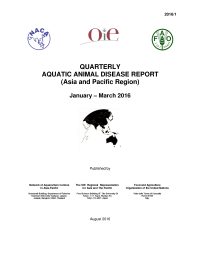Reported Aquatic Animal Diseases in the Asia-Pacific Region during the First and Second Quarters of 2021
29 October 2021 | Eduardo Leaño | 5167 views | Australia, Freshwater finfish, Health and Biosecurity, Marine finfish, Molluscs (shellfish and other), Philippines, Shrimp, Sri Lanka, Thailand
With the implementation of the new aquatic animal disease reporting in the Asia Pacific region from January 2021, and in lieu of the published QAAD Reports (last issue published was 4th quarter of 2020), NACA will be reporting aquatic animal diseases that are occurring or present in the countries of the region, on quarterly basis. This report covers the first and second quarters of 2021 and the original and updated reports are also available. The following diseases were reported:
Finfish Diseases
- Infection with Aphanomyces invadans (EUS): Australia in bream (Acanthopagrus australis), flathead (Platycephalus sp.), estuary cod (Epinephelus coioides), sand whiting (Sillago ciliata) and flathead grey mullet (Mugil cephalus); and, Chinese Taipei in largemouth bass (Micropterus salmoides).
- Viral encephalopathy and retinopathy (VER): Australia in giant grouper (E. lanceolatus), sea mullet (M. cephalus), freshwater mullet (Trachystoma petardi), sandy sprat (Hyperlophus vittaus), Nepean herring (Pomatalosa richmondi), and estuary perchlet (Ambassis marianus); Chinese Taipei in hybrid grouper (E. fuscoguttatus x E. lanceolatus); New Caledonia (affected species not specified); and, Singapore (diseased grouper and pompano).
- Infection with red seabream iridovirus (RSIV): Chinese Taipei in hybrid grouper (E. fuscoguttatus x E. lanceolatus).
Infection with Koi herpesvirus (KHV): Chinese Taipei in common carp (Cyprinus carpio). - Carp edema virus disease (CEV): New Caledonia (affected species not specified).
- Infection with Tilapia lake virus (TILV): and, Philippines in tilapia (fry, fingerlings and juveniles).
Molluscan Diseases
- Infection with Bonamia exitiosa: Australia in Sydney rock oyster (Saccostrea glomerata).
- Infection with Perkinsus olseni: Australia in farmed green lip abalone (Haliotis laevigata).
- Infection with abalone herpesvirus: Australia in wild green lip abalone (H. laevigata) and black lip abalone (H. rubra).
Crustacean Diseases
- Infection with white spot syndrome virus (WSSV): Philippines in tiger shrimp (Penaeus monodon), white shrimp (P. vannamei), Indian prawn (P. indicus) and mudcrab (Scylla olivacea); Singapore in a batch of imported ornamental crayfish; and, Sri Lanka in tiger shrimp (P. monodon) and white shrimp (P. vannamei).
- Infection with infectious hypodermal and haematopoietic necrosis virus (IHHNV): Philippines tiger shrimp (P. monodon) and white shrimp (P. vannamei); and, Thailand (shrimp species not specified).
- Acute hepatopancreatic necrosis disease (AHPND): Philippines in white shrimp (P. vannamei); and, Thailand (shrimp species not specified).
- Hepatopancreatic microsporidiosis caused by Enterocytozoon hepatopenaei (EHP): Chinese Taipei in white shrimp (P. vannamei); Philippines in tiger shrimp (P. monodon) and white shrimp (P. vannamei); and, Thailand (shrimp species not specified).
- Infection with decapod iridescent virus 1 (DIV-1): Chinese Taipei in white shrimp (P. vannamei).
Amphibian Diseases
- Infection with Ranavirus species: Chinese Taipei bullfrog (Lithobates catesbeianus).
- Infection with Batrachochytrium dendrobatidis: New Caledonia (affected species not specified).
Other Diseases
Singapore reported infections with: scale drop disease virus (SDDV) in Asian seabass (Lates calcarifer); lymphocystis virus in red snapper (Lutjanus sp.); Nocardia spp. in diseased threadfin (Eleutheronema sp.) and red snapper; Streptococcus iniae in red snapper; and, Tenacibaculum sp. in diseased pompano.
E.M. Leaño, Senior Programme Officer, Aquatic Animal Health Programme
Creative Commons Attribution.
